Introduction - Species Plantarum Programme
Introduction - Species Plantarum Programme
Introduction - Species Plantarum Programme
You also want an ePaper? Increase the reach of your titles
YUMPU automatically turns print PDFs into web optimized ePapers that Google loves.
38<br />
SPECIES PLANTARUM — FLORA OF THE WORLD (1999)<br />
adnate: fused to an organ of a different kind, e.g. applied to a stamen fused to a petal.<br />
adventitious: arising in abnormal positions, e.g. roots arising from the shoot system, buds<br />
arising elsewhere than in axils of leaves.<br />
adventive: introduced to an area recently. cf. introduced, naturalised.<br />
aerenchyma: tissue incorporating large, gas-filled spaces interspersed with the cells in a<br />
characteristic pattern.<br />
aestivation: the arrangement of sepals and petals or their lobes in an unexpanded flower bud.<br />
cf. vernation.<br />
aggregate fruit: a cluster of fruits formed from the free carpels of one flower. cf. syncarp.<br />
albumen: = endosperm.<br />
allantoid: sausage-shaped.<br />
allopatric: of two or more taxa, having different ranges of distribution. cf. sympatric.<br />
alternate: of leaves or other lateral organs, borne singly at different heights on the axis; of<br />
floral parts, on a different radius, e.g. describing the position of stamens with respect to<br />
petals. cf. opposite.<br />
alternitepalous: of floral parts, inserted alternately with the tepals.<br />
alveolate: pitted or honeycombed on the surface.<br />
amplexicaul: of a leaf base, stem-clasping.<br />
anastomosis: fusion to form a network, e.g. of veins in a leaf blade.<br />
anatropous: of an ovule, inverted so that the micropyle faces the placenta.<br />
anauxotelic: applied to inflorescences, parts of inflorescences or to axes that do not end in a<br />
flower, and in which growth does not continue beyond the flowering region, cf.<br />
auxotelic.<br />
androdioecious: having bisexual flowers and male flowers, on separate plants.<br />
androecium: the stamens of one flower collectively.<br />
androgynophore: a stalk bearing both the androecium and gynoecium of a flower above the<br />
level of insertion of the perianth.<br />
androgynous: having male and female flowers in the same inflorescence.<br />
andromonoecious: having bisexual and male flowers, on the same plant.<br />
androphore: a stalk bearing the androecium.<br />
anemophilous: pollinated by wind.<br />
angiosperm: a seed-bearing plant whose ovules, and hence seeds, develop within an<br />
enclosed ovary. cf. gymnosperm.<br />
angustiseptate: with narrow partitions, cf. latiseptate.<br />
annual: a plant whose life span ends within one year after germination.<br />
annular: arranged in or forming a ring.<br />
annular corona: raised fleshy tissue, usually in a ring, on the corolla around the base of the<br />
staminal column but not closely adnate to it.<br />
annulus: a ring; in ferns, the elastic ring of cells, forming part of the sporangium wall, that<br />
initiates dehiscence.












